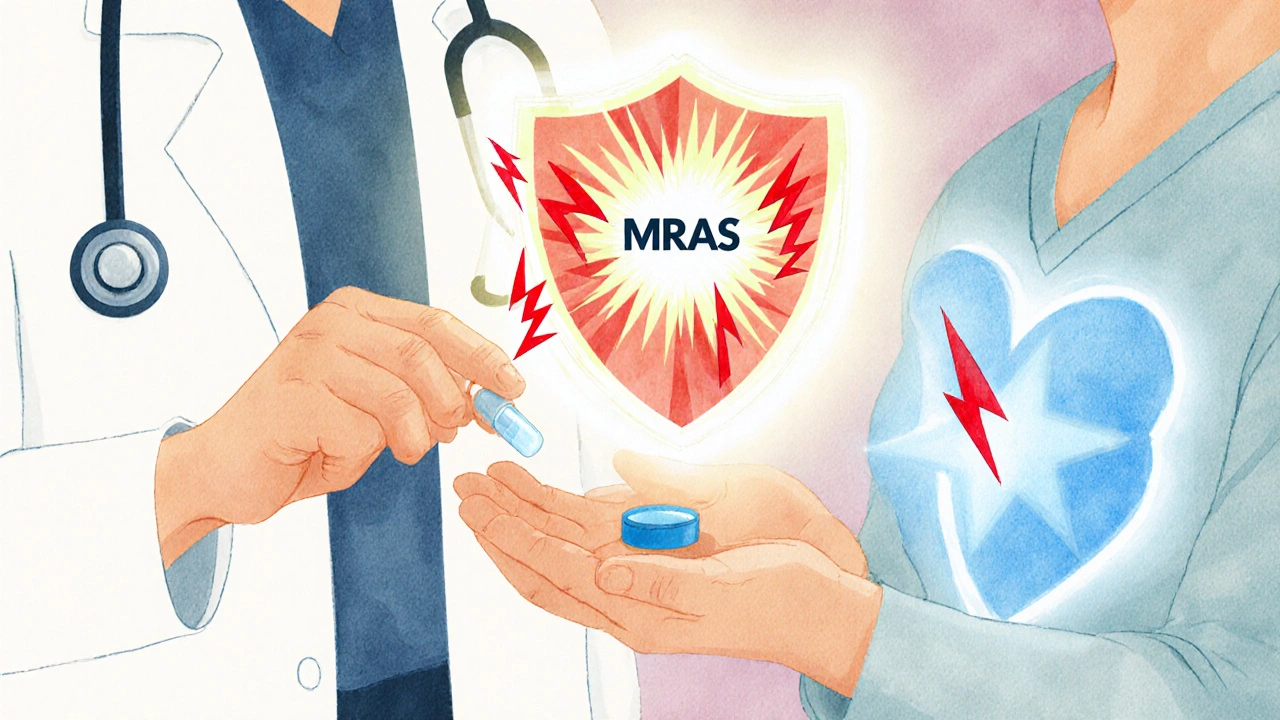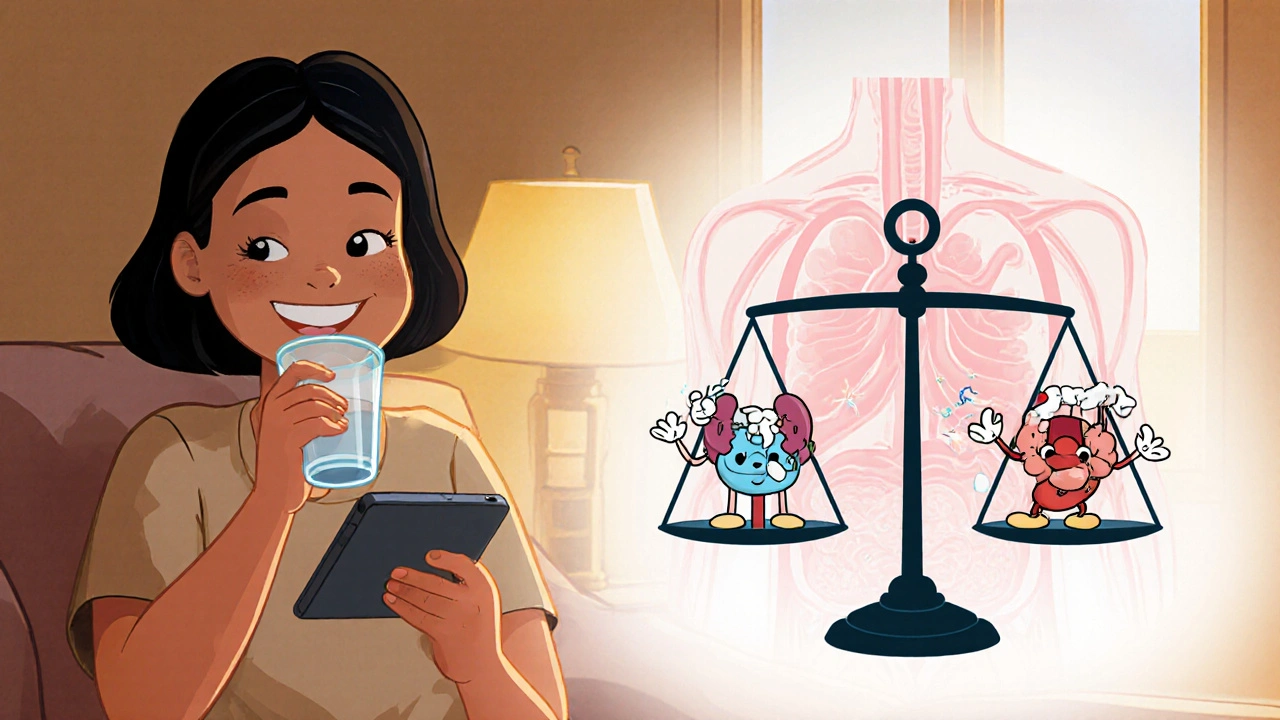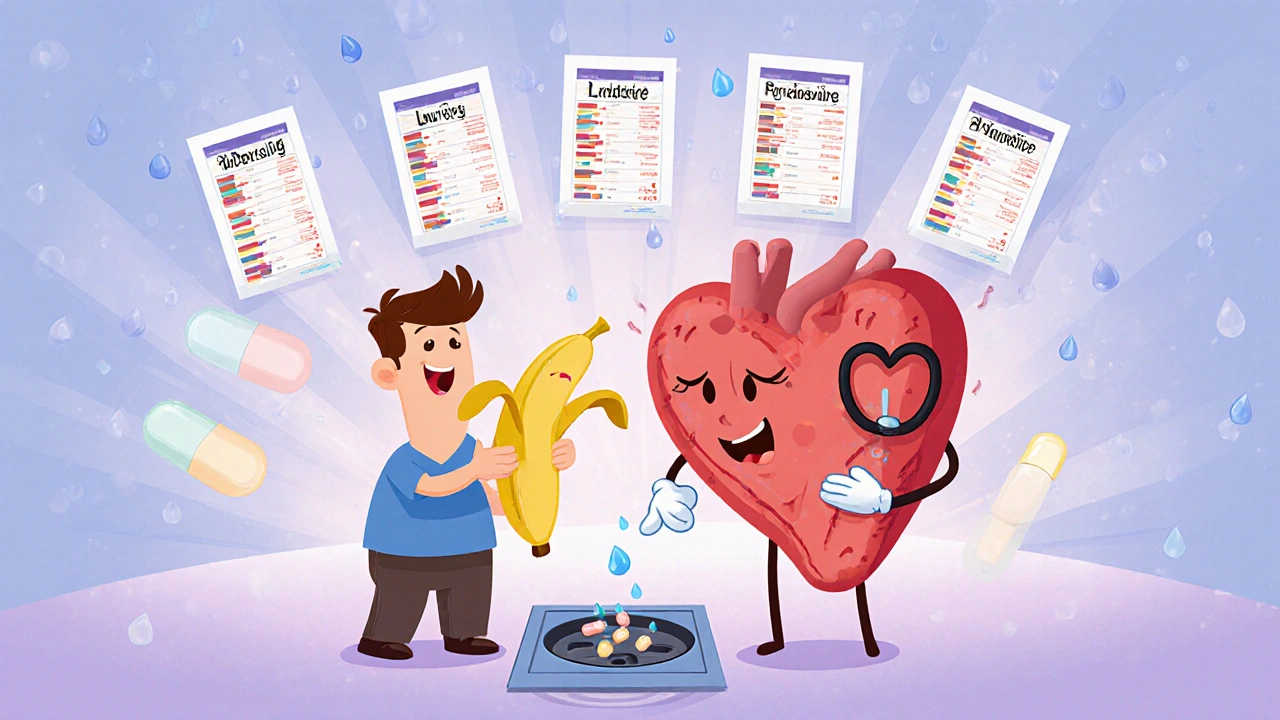Hypokalemia Risk Calculator
Diuretic Management Risk Assessment
Calculate your risk of hypokalemia based on your treatment regimen and health factors
Risk Assessment
Recommended Actions
When you're managing heart failure, diuretics are often the first line of defense against fluid buildup. But there's a hidden risk that many don't talk about until it's too late: hypokalemia. Low potassium isn't just a lab value-it's a silent trigger for dangerous heart rhythms, hospital readmissions, and even sudden death. If you're on loop diuretics like furosemide or torsemide, your potassium could be dropping without you noticing. The good news? It’s preventable. And it doesn't require complex solutions-just smart, consistent steps.
Why Diuretics Lower Potassium in Heart Failure
Loop diuretics work by blocking salt reabsorption in the kidneys. But here’s the catch: when salt gets flushed out, so does potassium. Every time you pee more, you lose more potassium. In heart failure patients, this isn’t just a side effect-it’s a major threat. Studies show that 20-30% of people on daily loop diuretics develop hypokalemia (potassium below 3.5 mmol/L). The risk jumps higher if you’re on large doses, have kidney problems, or take other meds like laxatives or steroids.The problem gets worse because the body adapts. After a few days of the same diuretic dose, your kidneys start holding onto sodium again. This means you need higher doses to keep the fluid off, which leads to even more potassium loss. It’s a cycle: more diuretics → more potassium loss → more arrhythmia risk → more hospital visits.
Why Low Potassium Is Dangerous in Heart Failure
Potassium isn’t just for muscle cramps. It’s what keeps your heart beating steadily. When levels drop below 3.5 mmol/L, the electrical system of your heart becomes unstable. For someone with heart failure-whose heart is already weakened-this can mean ventricular tachycardia, fibrillation, or sudden cardiac arrest. Research shows that heart failure patients with potassium below 3.5 mmol/L have a 1.5 to 2 times higher risk of dying compared to those with normal levels.And it’s not just about the number. Even mild drops-say, from 4.0 to 3.6 mmol/L-can increase arrhythmia risk in people with scar tissue from past heart attacks or long-standing high blood pressure. The heart doesn’t need to be severely damaged for low potassium to become dangerous. That’s why checking potassium isn’t optional. It’s part of routine care.
How to Correct Hypokalemia Safely
If your potassium is low, don’t just reach for a banana. You need a plan. For mild cases (3.0-3.5 mmol/L), oral potassium chloride is the standard. Most doctors start with 20-40 mmol per day, split into two doses to avoid stomach upset. For severe cases (below 3.0 mmol/L), you’ll need IV potassium in the hospital-with continuous ECG monitoring. Giving too much too fast can cause cardiac arrest, so this isn’t something to do at home.But here’s the key: fixing potassium once isn’t enough. You need to stop the leak. That’s where potassium-sparing medications come in. Mineralocorticoid receptor antagonists (MRAs) like spironolactone and eplerenone are game-changers. Spironolactone, at 12.5-25 mg daily, doesn’t just help with potassium-it cuts death risk by 30% in patients with reduced heart function (HFrEF), as shown in the landmark RALES trial. Eplerenone works similarly and is often preferred if you can’t tolerate spironolactone’s side effects.
When to Use SGLT2 Inhibitors
In the last five years, a new class of drugs has changed how we think about diuretics and potassium. SGLT2 inhibitors-like empagliflozin and dapagliflozin-were originally designed for diabetes. But in heart failure, they do something remarkable: they reduce fluid overload without pulling out potassium. In fact, they often raise potassium slightly.Clinical trials show these drugs cut diuretic needs by 20-30%. That means less potassium loss overall. They’re now recommended for all heart failure patients with reduced or preserved ejection fraction, regardless of diabetes status. If you’re on high-dose furosemide and still bloated, adding dapagliflozin 10 mg daily might let you lower your diuretic dose-and protect your potassium at the same time.

Adjusting Diuretic Dosing to Protect Potassium
How you take your diuretic matters as much as what you take. Giving a single large dose of furosemide in the morning causes a big spike in potassium loss, followed by a rebound where your body starts holding onto salt again. That’s why splitting the dose-say, 20 mg in the morning and 20 mg at lunch-can smooth out the effect. It reduces the peaks and valleys in potassium loss, making levels more stable.For patients who need stronger diuresis, combining a loop diuretic with a low-dose thiazide like metolazone (2.5-5 mg daily) can help. But this combo is a double-edged sword: it works better, but it also increases hypokalemia risk. So if you’re on this combo, you need potassium checked every week until stable, then monthly.
Watch Out for Hidden Potassium Killers
It’s easy to blame the diuretic-but other things are working behind the scenes. Sodium restriction, while good for heart failure, can actually make potassium loss worse. When you cut salt, your body releases more aldosterone, which tells your kidneys to dump potassium. So don’t go too low-80-120 mmol of sodium per day (about 2-3 grams) is the sweet spot. Less than that can backfire.Other culprits? Laxative abuse, vomiting, or even overuse of herbal diuretics like dandelion root. If your potassium keeps dropping despite treatment, ask: “What else am I taking?” Even over-the-counter supplements can interfere.
Monitoring: When and How Often
You can’t manage what you don’t measure. When starting or changing diuretics, check potassium every week for the first month. Once stable, monthly checks are enough-but if you’re sick, hospitalized, or your dose changes, go back to weekly. In acute heart failure, check every 1-3 days. Don’t wait for symptoms-weakness, palpitations, or muscle cramps mean you’re already behind.Also, check kidney function (eGFR) at the same time. If your kidneys are failing, you can’t clear potassium well. But in heart failure, low eGFR doesn’t always mean high potassium-it can mean you’re not excreting enough sodium, so you’re on more diuretics, which lowers potassium. It’s a balancing act.

What About HFpEF?
Not all heart failure is the same. Patients with preserved ejection fraction (HFpEF) don’t respond to diuretics the same way as those with reduced function (HFrEF). Aggressive fluid removal in HFpEF can worsen kidney function without improving symptoms. That means you need to be even more careful with diuretic doses. Less is often more. And if potassium drops, don’t rush to push more diuretics-reassess the whole picture.Looking Ahead: What’s New
Newer diuretic formulations-like extended-release torsemide-are being studied to provide steadier effects over 24 hours, reducing the spikes that cause potassium swings. Biomarker-guided dosing (using BNP or NT-proBNP levels to adjust diuretics) is showing promise in trials, cutting hypokalemia rates by 15-20% compared to standard care.And while potassium binders like patiromer or sodium zirconium cyclosilicate are mostly used for high potassium, they’re being explored for fine-tuning in complex cases-especially when you need to keep MRAs going but your potassium keeps climbing and falling.
The future is personalized. Not everyone needs the same dose, same drug, or same monitoring schedule. Your age, kidney function, other meds, and how your body responds matter more than ever.
Can I just take potassium supplements without a prescription?
No. Over-the-counter potassium supplements in the U.S. are limited to 99 mg per pill because higher doses can cause dangerous heart rhythms. If your potassium is low, you need a doctor’s prescription for the right strength and form. Self-treating can be risky, especially if you have kidney disease.
Do all diuretics cause hypokalemia?
No. Loop diuretics (furosemide, torsemide) and thiazides (hydrochlorothiazide) cause the most potassium loss. Potassium-sparing diuretics like spironolactone, eplerenone, and amiloride do the opposite-they help keep potassium in. That’s why they’re often added to other diuretics in heart failure.
Can eating more bananas fix low potassium?
Bananas are a good source of potassium, but you’d need to eat 6-8 a day to replace what you lose on diuretics. That’s not practical or safe-it can cause too much potassium if your kidneys aren’t working well. Food helps, but it doesn’t replace medical treatment.
Why do I need to check potassium if I feel fine?
Hypokalemia often has no symptoms until it’s severe. By the time you feel weak or have palpitations, your heart is already at risk. Regular blood tests catch it early-before it becomes dangerous. That’s why doctors insist on it, even when you feel okay.
Is it safe to stop my diuretic if my potassium is low?
Never stop diuretics without talking to your doctor. Fluid overload in heart failure can kill faster than low potassium. The goal isn’t to stop the diuretic-it’s to manage the potassium loss with safer meds, dosing, or add-ons like MRAs or SGLT2 inhibitors.

Comments
Sakthi s
Simple and smart. Just keep checking potassium and stick with the MRAs. Your heart will thank you.
On November 17, 2025 AT 14:15
vanessa parapar
Oh honey, I've seen so many patients ignore this until they're in the ER with VTach. Bananas aren't magic. You need real meds. Spironolactone isn't optional-it's the backbone. And yes, SGLT2 inhibitors? Game changer. Stop treating this like a diet problem.
On November 19, 2025 AT 10:01
Ben Wood
Let me be clear: the author is correct-but only if you're following the 2022 AHA/ACC/HFSA guidelines, which, frankly, most primary care docs haven't read since 2019. And please, stop calling it 'hypokalemia' like it's some exotic disease-it's just potassium depletion, and it's preventable with basic electrolyte management. Also, 'dandelion root'? That's not a drug, it's a weed tea. If you're drinking that instead of spironolactone, you're not just at risk-you're a statistic waiting to happen.
On November 20, 2025 AT 13:54
Robert Altmannshofer
One thing I love about this breakdown is how it treats potassium like a living thing-not just a number on a lab report. You're not fixing a value, you're stabilizing a heartbeat. And that shift in mindset? That's what saves lives. I've seen people go from 'I feel fine' to 'I almost died' because they didn't connect the dots between their furosemide dose and that weird flutter in their chest. This isn't just medical advice-it's a survival guide.
Also, SGLT2 inhibitors? They're not just for diabetics anymore. They're the quiet heroes of heart failure care. If your doc hasn't mentioned them, ask. Politely. But ask.
On November 20, 2025 AT 14:03
Julia Jakob
so like... if you're on diuretics and your potassium is low... are you just supposed to trust the system? because i swear every time i go to the dr they're like 'oh we'll check it next month' and then i get dizzy and my heart does that thing and i'm like... is this normal?? no one ever says what to do in the meantime. also why is everyone so chill about this?? it's literally a silent killer and we're all just sipping tea and waiting for the next blood test??
On November 22, 2025 AT 09:26
Kathleen Koopman
Thank you for this! 🙏 I’ve been on torsemide for 3 years and my potassium always dips. I started taking spironolactone last year and my cardiologist said I’m now ‘a poster child for proper management.’ I didn’t know I could feel this good again. Also, dapagliflozin? Changed my life. No more bloating at 3 p.m. 😌
On November 24, 2025 AT 06:09
Abhi Yadav
we are all just temporary vessels of electrolytes anyway... the body is a storm of ions... potassium is the whisper that holds the thunder... when it fades... the rhythm forgets itself... and the heart... the heart remembers only the silence
On November 26, 2025 AT 02:52
Nancy M
As a nurse practitioner in a rural clinic, I can confirm: the biggest barrier to proper potassium management isn't lack of knowledge-it's access. Many of my patients can't afford spironolactone. Some skip doses because they're worried about kidney function. Others don't have transportation for monthly labs. This article is excellent-but it assumes privilege. We need policy changes, not just protocols.
On November 28, 2025 AT 00:04
gladys morante
I've been on 80mg of furosemide for years. My potassium is always low. I've tried everything. Bananas, oranges, coconut water, potassium pills, even salt substitutes. Nothing works. I'm just waiting for the day my heart gives up. And no one ever says that's a possibility. They just say 'take your meds.' But what if your meds are killing you slowly?
On November 28, 2025 AT 12:32
Precious Angel
Let me tell you something they don't want you to know: the pharmaceutical industry doesn't want you to fix potassium naturally. Why? Because potassium supplements are cheap. Spironolactone? Patent protected. SGLT2 inhibitors? $1,200 a month. They'd rather you stay dependent on expensive drugs than teach you how to eat real food, reduce sodium properly, and use herbs like hawthorn berry or magnesium citrate-things that actually stabilize rhythm without the side effects. The 'guidelines' are written by doctors who get paid by drug reps. Don't be fooled.
My cousin died at 52 from 'sudden arrhythmia' after being on furosemide for 7 years. They told her it was 'just heart failure.' But I looked at her labs-her potassium was 2.9 for months. No one adjusted. No one cared. Now I only trust natural medicine. And I don't trust hospitals.
On November 29, 2025 AT 12:23
Melania Dellavega
This is the kind of post that makes me believe medicine still has heart. Not just the mechanical kind-the kind that sees the person behind the lab values. I’ve been managing HFpEF for five years, and this is the first time I’ve read something that didn’t feel like a textbook. The part about 'less is more' in HFpEF? That’s the truth I’ve been screaming into the void. Thank you for saying it out loud.
And to everyone else: if you’re reading this and you’re scared, you’re not alone. We’re all just trying to keep our hearts beating while the world moves too fast. Take a breath. Check your potassium. Call your doctor. You’ve got this.
On November 30, 2025 AT 17:47
Bethany Hosier
While I appreciate the clinical rigor of this piece, I must raise a concern regarding the implicit endorsement of pharmaceutical interventions without sufficient acknowledgment of the systemic failures in healthcare delivery. The suggestion that SGLT2 inhibitors are universally accessible or affordable is, in my view, a dangerous oversimplification. In the United States, even with insurance, copays for these agents frequently exceed $500 per month. This is not a medical issue-it is a socioeconomic crisis masquerading as a clinical guideline.
Furthermore, the omission of dietary potassium bioavailability in relation to soil depletion and processed food consumption is a glaring omission. Modern agriculture has reduced potassium content in produce by over 50% since 1950. Is it truly reasonable to expect patients to 'eat more bananas' when their local grocery store sells genetically modified, nutrient-depleted produce at inflated prices? This is not patient noncompliance-it is structural violence.
Lastly, I must question the ethics of promoting MRAs without addressing the risk of hyperkalemia in elderly patients with concomitant CKD. The RALES trial cohort was carefully selected. Real-world populations are far more complex. We must stop treating guidelines as gospel and start treating them as starting points for individualized care.
On December 1, 2025 AT 06:53
Krys Freeman
Why are we even talking about this? Just give them the pill. No one cares about your potassium numbers. If you can't handle a little diuretic, maybe you shouldn't be alive. America's getting soft.
On December 2, 2025 AT 19:02
Rachel Nimmons
Thanks for this. My dad’s on spironolactone now. He’s sleeping better. We’re finally breathing again.
On December 2, 2025 AT 19:23